Cageside Features Guest Columnist John S. Nash brings us part one of a fascinating four-part series shining a gas light on the forgotten golden age of mixed martial arts, an age that existed during the Belle ?poque.
This is a recently revised article, which was originally cross-posted at our fellow SBNation Blog, Bloody Elbow.com by Cageside Features Guest Columnist John S. Nash on Dec, 4, 2010 [?]
__________________________
"The evolution of martial arts since 1993 (since the UFC came around) martial arts have evolved more than they have in the last 700 years. We know exactly now what works in a real live situation with two warriors fighting; for a long time that was just speculation."
- Joe Rogan
It is common knowledge amongst fans of the sport of mixed martial arts that the first Ultimate Fighting Championship ushered in a "golden age" of MMA. Sure, it had a predecessor in Brazilian Vale Tudo and Japanese "shooto" wrestling matches, but those were merely the prologue for what was to follow.
What Art Davie and Rorion Gracie unleashed with UFC 1 was something unseen in the annals of unarmed combat: the opportunity for the best fighters in the world from two different disciplines to test themselves, and their art, in a simulation of a real world combat scenario.
No longer would we have to imagine who would win in a hypothetical matchup between, say, a wrestler and a judoka, or try to calculate who employed the more effective striking between a savateur, a boxer, or a karateka; because now we would be given the definitive answer.
For the first time since the ancient Greeks participated in pankration, martial arts would move beyond the philosophical to the empirical. Thus, a "golden age" was born.
Unfortunately, none of the above is true.
What most fans of MMA are not aware of, is a previous "golden age" of mixed martial arts existed, one where much of the progress we currently enjoy was made and where most of our questions were answered. This previous era saw unrivaled progress in ancient disciplines, the emergence of new hybrid fighting styles, the pitting of the different disciplines against one another in no-holds-barred combat, and the presence of some of history's greatest unarmed combatants.
All of this existed a century before the first fighter ever stepped foot in the Octagon; during the "golden age" that was the Belle ?poque.
_____________________
The Belle ?poque, or the Gilded Age, as it was referred to in the United States, is the name given to the period around the turn of the 20th century (beginning in 1870, with the end of the Franco-Prussian war, and lasting until the first shots of the Great War).
It was a remarkable time, one that saw the world drastically shrink. The introductions of the automobile, aeroplane, giant Ocean liner, telephone, and Cin?matographe shepherded in vast societal changes and led to unprecedented advances in the sciences, arts, technology, and literature.
The field of the martial arts would be no different.
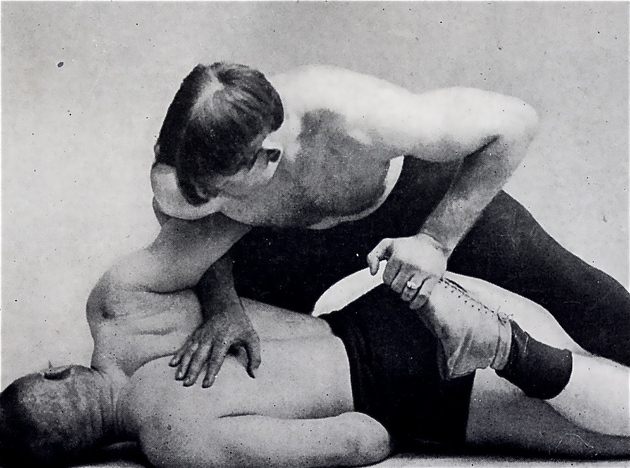
"...There is a more powerful influence toward making a man roll over on his back or simply quit outright... it is pain."
- Frank Gotch
Since the first Ultimate Fighting Championship, two disciplines have consistently proven themselves to be the most effective in the sport of mixed martial arts: wrestling and jujutsu (or "jiu-jitsu").
Both of these genres would see their greatest accomplishments achieved during the Belle ?poque. In fact, wrestling, even with its millennia of history, would reach its zenith during this era, thanks to a confluence of circumstances, beginning with the American Civil War.
In the United States of America, wrestling has always been a sport popularized amongst its citizens. That interest grew exponentially during the nation's Civil War, as soldiers, looking for diversions during the long lulls between fighting, took up grappling as a means to offset the boredom.
Amongst the Union soldiers, "collar-and-elbow" became the preferred style, as it was already immensely popular with the Irish and Vermont troops. Therefore, the readily understood rules made it easier for members of different regiments to compete with one another.
After the war, returning veterans retained their passion for the sport, spreading their interest and new found knowledge across the land. Soon, it was the nation's pastime as innumerable leagues, county tournaments, and state meets sprung up to fill the competitive void.
Interest was such that the first nationally recognized heavyweight champion was crowned in 1880, when William Muldoon defeated Thebaud Bauer in front of 3,000 people in New York City. Oddly enough, they did not wrestle in "collar-and-elbow", but in the misnamed "Greco-Roman" form (a more accurate name for the new style would be "French flat-hand wrestling").
Muldoon's victory made him arguably the country's most famous athlete, sparking such an interest in Greco-Roman wrestling that it soon became the preeminent style. That position would not last, however.
To cater to this new found interest in all things wrestling, the barnstormers and carnivals that traveled the land began offering wrestling exhibitions as part of their "Athletic Show" (or "AT Show" as they were known). An important part of the "AT show" involved the carnie wrestlers offering a challenge, and cash prize, to any local who could best them.
To accommodate the many folk styles being used by the large influx of immigrants in the post-bellum, necessity dictated something besides Greco-Roman or collar-and-elbow be used. The barnstormers turned to the "all-in" style of Lancashire Catch-as-Catch-can for inspiration, coming up with an even laxer set of rules, often referred to as "no-holds-barred".
No-holds-barred proved immensely popular with the public, resembling the free-for-all (a watered down rough-and-tumble or "no rules") wrestling, which was common in many parts of the country.

Another important aspect of "AT Show" Catch-as-Catch-can wrestling, was the way in which it allowed for victory by a form of submission, often referred to as concession.
Not only were submissions or concessions more popular than throws (pins) amongst the lower classes (who had grown up on rough-and-tumble matches which only ended when one man quit), but they also had the added benefit of allowing a wrestler to use "hooks".
"Hooking" was the art of using techniques that were either unknown to the general public, or technically illegal under most rules. "Hooking" was helpful for two reasons: First, is how it gave the wrestler who used them an advantage over any wrestler unfamiliar with these techniques. This was an important weapon to have in one's arsenal. Particularly when facing a talented local, who may have proven to be too dangerous to risk engaging in a straight-up wrestling match.
Secondly, hooking made it easier for a wrestler to eliminate their challenger. By finishing a match as speedily as possible, not only did the carnival wrestler protect himself from potentially getting injured, but it also allowed him to go through a much greater number of challengers in one day, thereby earning more. Thus, there was a natural incentive to learn how to hook.
"AT shows" provided the perfect environment for the development of American Catch-as-Catch-can (although, ironically enough, it also introduced the showmanship and hippodroming that would eventually doom legitimate professional wrestling), at its heart being the pledge to "accept all challengers".
The wrestlers working the shows faced an endless stream of competition. Facing a dozen challengers per day was not an uncommon occurrence, giving them countless hours to hone their craft. The challengers varied from drunken louts and local toughs, to county champs skilled in a multitude of different folk styles, and the occasional dreaded ringer.
For the barnstormer, there was always the risk that day's challenger was not really a young farmer bringing pigs to town, a funny looking yokel wrestling in his drawers, or a veteran of the Philippines Insurrection named Frank Kennedy, but really Martin Burns, Fred Grubmier, or Frank Gotch in disguise. "Ringers" such as these, provided "AT show" wrestlers a chance to test their skills against their fellow "hookers".
In this environment, American Catch-as-Catch-can wrestling went through a Darwinian evolution, quickly becoming an amalgamation of all the folk wrestling of the new and old world. Thus, incorporating backwoods "rough and tumble", freed slave "knocking and kicking", British Lancashire, Cumbrian, Westmoreland, Cornish, and Devonshire (purring), as well as Scottish backhold, Irish collar-and-elbow and coraiocht, German/Austrian kampfringen and ringkampf, and French la luttes a main platte (or flat hand).
By the end of the 19th century, Japanese jujutsu holds were being added to the repertoire of many "hookers".
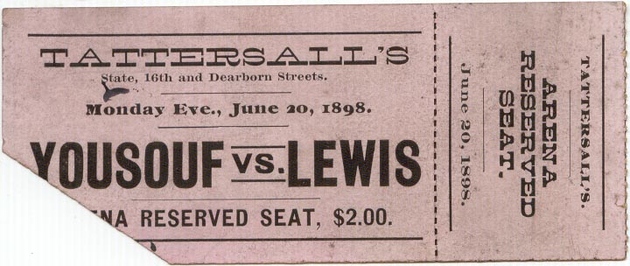
The ascendancy of Catch-as-Catch-can Wrestling as the premiere wrestling style of America was best symbolized by Evan "The Strangler" Lewis' odyssey to unify the various wrestling championships.
He gained his first title in 1887, in Chicago, Illinois, when he captured the World "Catch-as-Catch-can Championship" from Joe "The Little Demon" Acton, who was an English exponent of catch whom helped popularize it in the States. A few months later, at the Battery D Armory in that same windy city, he beat the Cornish wrestling champ, Jack Carkeek, in a mixed style Catch-as-Catch-can and Greco-Roman style match.
Finally, he faced Ernest Roeber, the prot?g? of William Mundoon, in a pair of highly anticipated matches. First, in 1890, for the "Collar-and-Elbow Championship", and then again in 1893, with both Lewis's "Catch-as-Catch-Can Championship" and Roeber's "Graeco-Roman Championship" on the line in a best of five match alternating between the two styles.
"The Strangler" would win both of these confrontations and from that point on the "Catch-as-Catch-can Champion" would be wrestling's Heavyweight Champion. These mixed wrestling matches, promoted heavily by Richard Fox's National Police Gazette, "did more to popularize the game than anything else".
Evan Lewis would eventually go on to lose the title, in 1895, to Iowan Martin "Farmer" Burns, a wrestler who would have a profound influence on the development of American wrestling. Burns' greatest contributions to the sport came after he lost the title to Dan McLeod in 1897.
Burns made an industry out of sharing his vast knowledge; opening gymnasiums around the country, developing an exercise regimen so highly regarded that Jim Jeffries hired him as his trainer, writing and publishing a popular mail-order course titled "The Lessons in Wrestling and Physical Culture"... all while also discovering and training such notables as Earl Caddock, Joseph "Toots" Mondt, Ralph Parcaut, and most famously, Frank Gotch.
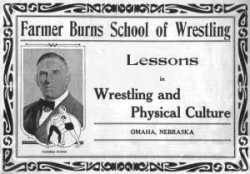
Burn's success can be attributed to an increased interest in amateur wrestling across the country, which in part, was fueled by a public interest in professionals, such as Burns. As the nation's urban centers grew, a movement started to organize sports as recreation for the industrial workers.
In 1888, the Amateur Athletic Union sanctioned its first national tournament, soon afterwards becoming recognized as the governing body for amateur wrestling in the United States. Athletic clubs opened across the nation offering wrestlers a place to train and compete.
In the early 20th century, colleges began to hold wrestling meets. In a few decades, wrestling had gone from a sport where two local toughs challenged each other, to one where hundreds of professional athletes supported themselves wrestling, and where a vast amateur network gave tens of thousands an opportunity to participate.
Catch-As-Catch-Can (circa 1903) via RagingBull1935
The wrestling which most of them participated in, Catch-as-Catch-can, was a particularly rugged and violent sport, as epitomized by a title match between Tom Jenkins and Frank Gotch on January 24, 1904, in Bellingham, Washington:
For over an hour, in what could be described as nothing more than a street fight, the two head-butted, elbowed, gouged, kneed, and slammed one another into bloody pulps. Finally, after surviving a head-scissors that brought blood from his nose and mouth, Frank Gotch got the upper hand, slamming Jenkins into the mat, cutting his jaw open and smashing his nose so badly he could not breathe.
A desperate Jenkins finally struck Gotch with a haymaker resulting in a disqualification by the exasperated referee. To the cheers of the blood-drenched spectators sitting ringside, Frank Gotch was proclaimed champion.
Such was the barbarity of these matches, that injury and even death were not unheard of. Professional wrestler Charles Olsen killed an opponent of his not once, but twice during his career. (At least Col. James Hiram McLaughlin had the good sense to swear off Catch-as-Catch-can after killing two of his opponents and leaving a third paralyzed.)
Eventually, the more dangerous and punishing holds were eliminated from the amateur game, resulting in the creation of freestyle (and eventually, collegiate) wrestling.

Meanwhile, Europe was going through its own wrestling renaissance. On the continent, Greco-Roman (French flat hand) wrestling style had become extremely popular, owing in part to a new found interest in "ancient values" and the mistaken belief that it was the wrestling of Plato (when in truth it was named so to mask its French origins from a continent where angry memories of Napoleon still lingered).
In the opera and musical halls of major cities, all across Europe, high profile international Greco-Roman tournaments were held, with large monetary prizes given to the place winners. From out of these tournaments emerged the first true global wrestling star -- George Hackenschmidt.
The Russian Lion, as Hackenschmidt was known, was an ardent follower of the physical culture movement, resembling more a Greek God carved from marble, than a man. He stood just over 175 cm tall [5'9"] and weighed 99 kg [218 pounds], with a 132 cm chest [52"] and an 89 cm waist [35"]. During this time, the average Londoner was around 170 cm tall [5'7"] and 66 kg [145 lbs].
His feats were as mythical as his physique. He was the inventor of the "Hack squat" and one of the strongest men in the world, capable of lifting 122 kg [269 pounds] with a single arm, or lifting and carrying a horse on his shoulders.
Moreover, he was also an expert cyclist and superb athlete, capable of doing standing jumps over a 1.22 m [4ft.] obstacle 100 times -- in succession. Additionally, he was a hyper polyglot and an intellectual, writing several books on philosophy and physical culture.
After winning both the Vienna and Paris World Championship Tournaments of 1901, back-to-back, the Russian Lion, now recognized as the undisputed Greco-Roman champion of Europe, turned his attention to London and Catch-as-Catch-can.
At the time, outside of Lancashire, wrestling held little interest for the English populace. A few professionals were making a living performing in Music Halls, alongside the strongman acts, but the best wrestlers, such as Tom Connors and Joseph Acton, often found a more receptive audience in the United States.
One who found some success in London, was the Cornish American Jack Carkeek. During his "performance" on March 2, 1902 at the Alhambra Theatre in London, he issued a challenge to any wrestler in the world, feeling secure in his knowledge that the only catch wrestlers who threatened him were safely on the other side of the Atlantic.
To his and the audience's astonishment, George Hackenschmidt, in full evening wear, jumped onto the stage to accept the challenge. Recognizing the grandstanding Russian Lion, Carkeek instantly withdrew his offer to a chorus of jeers.
The whole event caused a journalistic frenzy, and made Hackenschmidt an overnight sensation, which he quickly capitalized on. In 1902, he was proclaimed the World Champion after defeating the English Heavyweight champion Tom Cannon, even though he had yet to meet the American champ.
He rectified this in 1905, defeating "Rough" Tom Jenkins in two straight falls in New York City, to become the first truly undisputed champion. Professional wrestling now had a single, undisputed world champion wrestling under the Catch-as-Catch-can rules.
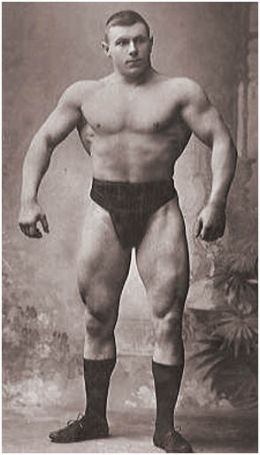
Hackenschmidt's success ignited a boom in London wrestling, with the Alhambra Theatre becoming the site of many of its most prestigious events. In 1908, it started to host the National Sporting Club open-to-the-world Catch-as-Catch-can tournament, where wrestlers from around the world, including a large contingent from Wigan (the traditional home of Lancashire wrestling), participated.
Much as the "AT shows" had done before, this London music hall Catch-as-Catch-can began to incorporate the many grappling techniques of its participants into its repertoire.
The biggest contributors proved to be Swiss schwingen (Armand Cherpillod, John Lemm), Indian Pehlwani (Gulam, The Great Gama, Iman Bux, Gobar Goho), Turkish ya?l? g?re? (The Terrible Turks: Youssuf Ismael, Hassan Nouralah, Ahmed Madrali), Japanese sumotori (Sorakichi Matsuda, Tomioki, Hamada Kurakichi), and perhaps most importantly, jujutsu and judo (Taro Miyake, Yukio Tani, Mitsuyo Maeda, Tsuatai "Rubberman" Higami).
Jujutsu became such an important part of catch wrestling that in his 1909 book, The Compete Science of Wrestling, George Hackenschmidt recommended wrestlers study jujutsu, as it included the leg sweeps, trips, and chokes that wrestling lacked. Around that same time, Len Lanius began to develop his Yankee Jiu Jitsu, for the purpose of "perfecting a style of defense to check their [jiu jitsu] attack".
Under the influence of these many disciplines, new styles developed, the most important being the "leg" wrestler - wrestlers who used their legs like another set of arms to control and contort their opponents into unbearable positions.
So how effective was the wrestling developed by these early 20th century professional Catch-as-Catch-can artists?
When matched against an amateur wrestler with a background in Greco-Roman, freestyle, or collegiate, no matter how skilled he was, the evidence clearly indicates that the amateur had little chance; be it John Pesak beating Olympic silver medalist Nat Pendleton in two straight falls, due to submission by toehold, or a 45-year old Clarence "The Octopus" Eklund pinning the entire Oklahoma A&M's 1933 NCAA national championship team, from lightweight to heavyweight, in only 15 minutes.
In a no-holds-barred match, the techniques developed over the years by the professional catch wrestler gave them a distinct advantage.
By this time wrestling, in both the old and new world, had reached its peak and a showdown was in order between the two camps. Representing Europe, would be the World Champion, George Hackenschmidt, while America's champion would be a student of Martin Burns, "The Iowa Plowboy" Frank Gotch.
In Gotch, Burns had found his greatest pupil, a 5' 11", 190-pound grappler who seemed to relish in the pain he inflicted upon his opponents.
Like many of the best in America, Gotch had come up through the carnival circuit. He was viewed by many as the greatest practitioner of scientific wrestling the world had seen. He was most renowned for his use of the "toe-hold" as a means of forcing his opponent to concede, or face excruciating pain or debilitating injuries.
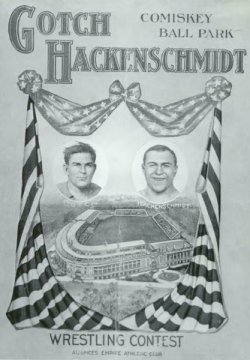
In 1908, the two met in front of 8,000 spectators in Chicago, Illinois, where after two hours of grappling, it finally ended when Hackenschmidt forfeited, rather than risk injury from Gotch's dreaded toehold. The match was not particularly exciting, and the victory was further tainted when afterwards, Hackenschmidt accused Gotch of cheating by eye-gouging and oiling himself up to prevent him from gaining a grip.
A rematch was arranged in 1911, and was the biggest prizefight in history at that time. With film cameras rolling and over 30,000 in attendance at Comiskey Ball Park in Chicago, Illinois, the world witnessed a debacle, as an injured and out-of-shape George Hackenschmidt was easily defeated in two straight falls.
Accusations were made that Hackenschmidt threw the fight, and that Gotch had hired Ad Santel to injure Hackenschmidt?s leg in training (the latter was easily proven false). The public soured on professional wrestling, equally tiring of the long boring matches in addition to the fixed matches.
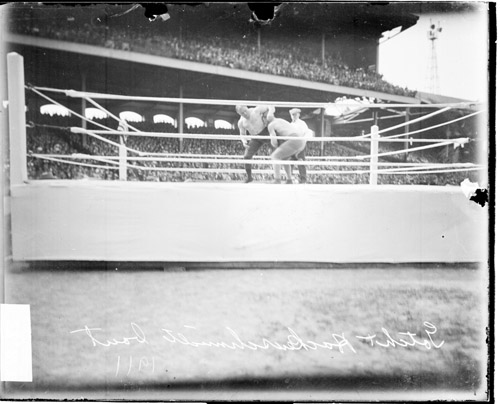
Would the public's displeasure last? Unfortunately, we will never know. Soon thereafter, on June 28, 1914, the Archduke Ferdinand was shot, triggering Europe's Great War. By the time, the guns went silent and the Armistice was signed at 11 am on November 11, 1918, the "golden age" of Catch-as-Catch-can wrestling was no more.
To be continued next week in: "The Forgotten Golden Age of MMA - Part II: The Rise of Judo and the Dawn of a New Age."
~~~~~~~~~~~~~
For additional history about the origins and early development of MMA: check out "James Figg: The Lost Origins of the Sport of Mixed Martial Arts".
____________________________________________
? -- This recently revised article by our Cageside Features Guest Columnist John S. Nash, has been 'crossposted' to Cagesideseats.com today (Dec. 1, 2012). In addition to delving into wrestling's past for Cageside Seats, Mr. Nash has regularly chronicled the forgotten history of mixed martial arts at our fellow SBNation Blog: BloodyElbow.com, where the original draft of this article was posted on Dec 4, 2010. Cageside Seats is proud to present the cross-posting of his entire archive of articles in this exclusive guest column for your enjoyment. To read more fascinating articles from Mr. Nash, simply bookmark this link and remember to check back frequently for new content.
____________________________________________
ADTL SOURCES:
- From Milos to Londos: The Story of Wrestling Through the Ages by Nat Fleischer
- Blood on the Sun: Yukio Tani by Graham Noble
- Early Jiu-Jitsu: The Challenges by Graham Noble
- The Life and Death of the Terrible Turk by Graham Noble
- The Lion of the Punjab' by Graham Noble
- Catch Wrestling: A Wild and Woolly Look at the Early Days of Pro Wrestingin America by Mark S. Hewitt
- Catch Wrestling, Round Two: More Wild and Woolly Tales From the Early Days of Pro Wresting by Mark S. Hewitt
- Fall Guys: The Barnum's of Bounce by Marcus Griffin
- A Review of the Nine Frank Gotch/Tom Jenkins Matches by Steve Yohe
- Ed "The Strangler" Lewis: Facts Within a Myth by Steve Yohe
- Joe Stecher by Steve Yohe and John Williams
IMAGES:
Special Thanks to: Thomas Nash
? ? ? ? ? ? ? ? ? ? ? ? ? ? ? ? ? ? ? ? ? ? ? ? ? ? ? ? ? ? ? ? ? ? ? ? ? ? ? ? ? ? ? ? ? ? ? ? ? ? ? ? ? ? ? ? ? ? ? ? ? ? ? ? ? ? ? ? ? ? ? ? ? ? ? ? ? ? ? ? ? ? ? ? ? ? ? ? ? ? ? ? ? ? ? ? ? ? ? ? ? ? ? ?
work it amy chua iowa gop meteor shower tonight annie oakley edc paranormal activity 4
No comments:
Post a Comment
Note: Only a member of this blog may post a comment.